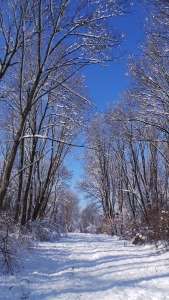Some forestlands cool climate better without trees, study finds

Forests worldwide are increasingly used to store carbon as a way to slow climate change, but a Dartmouth-led study finds that some wooded areas may be more valuable without trees, allowing the cleared landscape to reflect rather than absorb the sun's energy. In other words, it's better to have snow-covered ground act as a natural mirror if you want to use some forestlands to cool the climate.
The findings don't promote deforestation but suggest that carbon offset policies ignore a key way that forests interact with the atmosphere - namely surface reflectivity, or albedo - especially in high altitude areas with slow-growing trees and frequent snowfall.
The findings appear in the journal Ecological Applications.
"We aren't suggesting that removing carbon from the atmosphere isn't a crucial step in mitigating climate change, but it's very important that we enact policies that solve the problems they are designed to address," says lead author David Lutz, a research associate at Dartmouth. "In this case, there's evidence that carbon-centric offset policies miss some important complexities of how these natural systems operate."
New England's forests are increasingly used to generate carbon offset credits for climate frameworks, which involves long-term conservation of mature forests and/or reductions in the frequency and intensity of timber harvests. These climate frameworks assume forests only impact climate by storing carbon. But forests interact with the atmosphere in many ways, including surface reflectivity that reflects the sun's energy back into space instead of it being absorbed by the surface and re-radiated as heat energy. In this way, surface reflectivity lessens warming. "Our goal was to see if this carbon-only approach was appropriate, and we found that in some cases it likely was not," Lutz says. "Our findings suggest that these types of policies should definitely include additional considerations, such as albedo, in order to understand the full climatic influence."
The researchers used a computer model to look at nearly 500 forests across New Hampshire and calculate the influence of carbon storage and surface reflectivity on the optimal time to harvest timber. The results show that when carbon was the most valuable asset, long timber harvesting rotations made the most economic sense. But when surface reflectivity was the most valuable asset, short harvests made more economic sense because an open field has high reflectivity, particularly when covered in snow.
"We found that the optimal time to harvest varied quite considerably when albedo was given a value," Lutz says. "In particular, we found that in a handful of sites in New Hampshire, the harvest age approached zero. This suggests that in those locations, maintaining a cleared field with shrubs, grasses and other early successional growth was economically more valuable than if the forest was left alone to store carbon. This is really important because New Hampshire forest owners are lining up to receive offset credits from California's cap-and-trade program right now."
Much of the reason for the site-to-site differences came down to how much snow a site received as well as how productive it was—the more productive, the faster it could generate timber and store carbon. Not surprisingly, forests at high latitudes that grew slowly and received snow throughout the year were found to have shorter optimal harvest rotations.
"Our results shouldn't be interpreted as promoting rapid deforestation of high altitude forest stands, for instance in the White Mountains," Lutz says. "There are many benefits to having old growth forests, including aesthetics, habitat for birds and mammals, recreation, preventing erosion and maintaining water quality. Were we to add these components, our model may tell another story. We are actively working on adding in these pieces, but, as you can imagine, it is a complex process to model and place an economic value on each one, so we are working on them one at a time."
Says co-author Elizabeth Burakowski, a postdoctoral researcher at the National Center for Atmospheric Research: "The powerful cooling effect from deforestation relies heavily on the presence of snow. But scientists have estimated that snow cover could decline up to 50 percent by 2100 in New England. Though deforestation may provide cooling effects today, we cannot assume that will hold for the future. Forest management strategies will have to adapt to a warming climate, and our future studies will address this."
Journal information: Ecological Applications
Provided by Dartmouth College

















